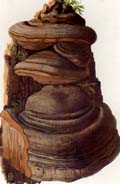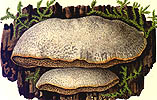Fruiting in dense clusters of thin-fleshed shelving fruiting bodies
Whiteoporus Tribe

 Key to Gilled Mushrooms Key
Key to Gilled Mushrooms Key Polyporaceae Family
Polyporaceae Family Small Sessilopolypore Subtribe
Small Sessilopolypore SubtribeSmall Imbricate Polypore SemiTribeFruiting in dense clusters of thin-fleshed shelving fruiting bodies | Links from Look-alikes Whiteoporus Tribe  Sessile cap entirely white to buff |

 Glossary |  Mushrooms |  |  People |  Newsletter |  Events |